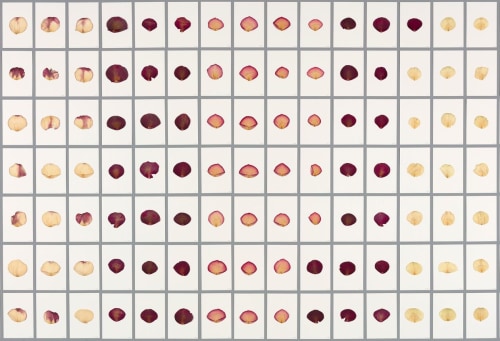
Nonfungible tokens will be backed by flower petals from a Sarah Meyohas work called ‘Cloud of Petals.’
PHOTO: SARAH MEYOHAS
The Wall Street Journal Meet Wall Street’s Crypto Artist
Sarah Meyohas’s work places her at the vanguard of an art-world revolution
By Bourree Lam
May 22, 2021 5:30 am ET
Sarah Meyohas’s work at the intersection of art, technology and finance earned the contemporary artist fame with financiers and tech geeks. Her latest piece aims squarely at the crypto crowd.
Long before Beeple’s digital collage fetched tens of millions of dollars at auction, Ms. Meyohas was experimenting with using the blockchain technology behind bitcoin to make art. The result looked a lot like the so-called nonfungible tokens that have powered millions in art sales in recent months, along with NBA Top Shot and other digital collectibles. NFTs are similar to bitcoin: Each one is unique, allowing them to act like deeds proving ownership of digital assets.
Ms. Meyohas’s work places her at the vanguard of this art-world revolution. She will be relaunching an early project, Bitchcoin, on the Ethereum network, with a public presale at Phillips auction house on May 25. Her 2015 project sold tokens entitling investors to portions of her photographic prints. The new Bitchcoins will be backed by flower petals from a previous work called “Cloud of Petals.”
“Big artists are like central banks, you control the supply, you have to show it at museums, it has to be appreciated culturally, and you create a market for your work,” said Ms. Meyohas in a recent interview. “The extreme of this is the artist becomes the currency.”
Ms. Meyohas said she doesn’t view buying an NFT as purchasing art in the traditional sense. The transparency of pricing makes her queasy, along with the encouragement of speculation, which happens at hyperspeed compared with the normal art world. Additionally, many of the artists who have been doing well financially tend to release “drops” of hundreds of the same image.
“It’s freely available information,” she said. “It’s a way to attach your identity and a stronger claim on this art than a like. NFT are social interactions.”
Bitchcoin functioned as a sort of proto-NFT, and the boom in digital tokens has brought a niche of tech-focused artists into the mainstream. Some use blockchain technology to find new buyers, or to authenticate digital works, which are easily replicated. Others use it in their art itself, raising questions about art’s relationship to ideas of value.
That continues a tradition from Marcel Duchamp’s “Monte Carlo Bonds”—sold to raise money to finance a system of winning at roulette—to J.S.G. Boggs, known for trying to spend his hand-drawn bank notes.
“Art is authorized by the artist; paper money is authorized by the bank,” said David Joselit, an art historian and professor at Harvard University. “Currency is a form of representation and has always been very close to the kind of representations of value art implicitly has.”
Ms. Meyohas began exploring those concepts as a student at Yale University’s master of fine arts program, when she learned about bitcoin and decided to use blockchain, which acts as a digital ledger storing information, to explore systems of value.
Bitchcoin was a play on bitcoin and a commentary on the financialization of the art world. They sold for $100, and buyers with 25 coins could trade them for one of her prints, even ones not yet produced. The opening party was held at Trinity Place, a restaurant inside a turn-of-the-century Wall Street bank vault commissioned by Andrew Carnegie.
Her 2016 “Stock Performance” earned Ms. Meyohas attention from Wall Street. In that work, she day-traded from Manhattan’s 303 Gallery, attempting to shift the share prices of various small, thinly traded companies. Then she painted the resulting stock charts. The paintings sold for $10,000, and the residency earned nationwide media coverage, with fans including Bloomberg financial columnist Matt Levine.
Ms. Meyohas revived Bitchcoin to mark her place in the NFT boom. Proponents say NFTs empower artists to sell their own work online, bypassing traditional auction houses. They also solve a key problem in the digital age: how to verify the authenticity of an infinitely replicable artifact that exists as computer code.
Still, some say the biggest beneficiaries are those artists with large followings before the craze took off, such as Beeple. The surge in activity on the Ethereum network has also meant that the cost of creating or trading an NFT on the network has risen recently. The dollar value of ether, the network’s in-house cryptocurrency, surpassed $4,000 for the first time this month, up from under $1,000 apiece at the start of the year. It is currently still over $2,000 after a selloff.
And there are signs that demand has eased. Sales of CryptoPunks—early NFTs of pixelated digital images of humans, aliens and other creatures—peaked in mid-March at about $21 million in one day, according to data-tracking site NonFungible.com.
Nasir Adaya, a quantitative researcher, has bought over 100 Bitchcoins in the private presale. His collective, a crypto venture studio, is planning to redeem some for artworks and hold some.
“The supply of NFTs is infinite right now,” said Mr. Adaya. “But a project backed by rose petals is unique.”
—Caitlin Ostroff contributed to this article.